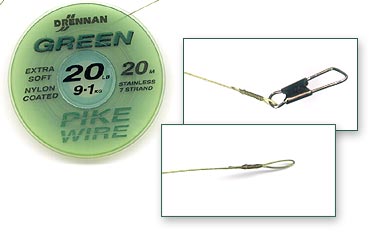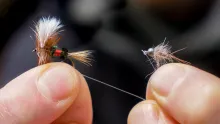Stiff piano wire has definite advantages over other sorts of pike shock and bite tippets.


Stiff piano wire has definite advantages over other sorts of pike shock and bite tippets.
We all know that pike are toothy critters. Those of us that have (fly)fished for pike for any length of time also generally have some scars on their fingers to prove it... Pike will easily demolish ordinary mono line if and when it gets between their teeth. This is a more immediate hazard when hardware fishing than when fly fishing for pike, since many lures, especially spinners, are smaller than pike flies, but even so, it is advisable, and probably better for the pike in the long run, to have a bite tippet of one sort or another on your fly when targeting the water wolf.
It will mean less frustration from accidentally lost pike, and also less pike swimming around with a broken off fly or lure lodged somewhere in their mouth (or worse...). And while a single hook left in a pike's mouth or digestive tract (usually from cutting the hook or line when a pike has swallowed too deep -- not uncommon when fishing with live or dead bait) usually presents no real problem for the fish, a complete fly or lure will.
What then are the options for bite tippets? There are several. Some people swear by heavy, hard mono, such as 30 lbs or heavier Mason or Amnesia. Personally I do not really trust heavy mono enough for pike fishing, unless with 'tiny' flies for small pike. Besides, I do not find it stiff enough to act as a bite tippet.
- The mono weights that ARE stiff enough are so heavy/thick that it is fairly impossible ot tie knots in them or attach your leader to them.
- Kevlar pike tippets are available in many brands and types, but being soft multistrand wires they suffer from a tendency to crinckle, kink and fray, and - in the end - break.
I prefer not to use them. - A popular alternative are the different incarnations of soft, multistrand steel wire. Some types have a plastic coating, some are made of a Kevlar/steel combination, and some are just multistrand steel.
- The Kevlar/steel ones are hell to tie knots on, and have a tendency to break under fatigue stress (usually at the moment a large pike is attached to the business end...).
- The plastic coated ones are easier handled and some of them are reasonably stiff. Still, knotting them is not easy. It is said that good knots and loops can be made, fixing the wraps by melting the plastic coating.
- Bare multistrand wire is most easily handled by creating loops with crimp sleeves -- however, that means that both ends need to be provided with additional hardware, such as a swivel and/or a snap. All multistrand wire material has a nasty habit of developing kinks, unintentional knots and other weak spots after even a few hours of fishing, that negate their primary purpose, i.e. protecting line, lure, and fish.
Again, I am not a big fan of them.
Coated pike wire calls for additional hardware such as a snap and crimp sleeves or wraps as seen here. It looks nice and straight here, but once it has kinked, it is almost impossible to straighten again.


Close the pliers tightly and start twisting the tag end around the standing end in tight turns.

Cut off the surplus wire and file down the tag end if you feel so inclined.

Make a small eye at the tip of the pliers for the tippet end of the piano wire and a larger eye for the fly end. Remember to slip on the fly before closing the fly end...
Many Dutch pike fliers use spinning wires, bite tippets that are made of single strand stainless steel piano wire, usually 0.5 or 0.7 mm in diameter, and about 8-12 inches (20-30 cm) in length.
Single strand wire is excellent for the purpose of preventing pike demolishing your line or leader. It is stiff enough for general fishing and is easily remodeled after mishaps that leave the bite tippet less than straight (such as hangups or fights of really huge pike). Besides, even after much bending and straightening, they will loose practically nothing of their strength, they don't kink and crinkle, and they are easily attached at the water's edge.
This, however, is precisely their weak point in my opinion -- they usually rely on a swivel snap at the fly/lure end for attachment to the hook. Most snaps out there aren't particularly reliable; I don't really care to remember how many fish I lost due to snaps bending, breaking, or just simply opening during a fight with or landing of a pike. Besides, you always carry one spare spinning wire too few when fishing. Therefore some years ago, I opted for integral bite tippets on all my pike flies, after reading a statement to that effect by noted Dutch pike specialist Ad Swier.
Integral bite tippets adopt all the pros of spinning wire tippets, while doing away with weak links and availability problems. Their only drawback, a minor one as far as I'm concerned, is that all your flies have these lengths of steel wire attached, which tend to get in the way when storing/transporting them. Usually the fly/wire combination can be hinged at the wire to hook attachment point, and thus folded, the combination will fit in most boxes or wallets suitable for pike flies, unless you make your wires extremely long.
It is my experience that a normal pike fly, with a hook at least 4/0, and 20-25 cm (8-10") integral wire tippet will fit most anything, and will be long enough to clear the line of any pike's teeth.
So how does one make an integral tippet? You'll need a supply of stainless steel piano wire, or spinner wire, in a 0.5-0.7 mm diameter. Any half decent hardware store or tackle shop should be able to supply this. You'll also need some tools, and some fairly good ones at that -- this is where the major cash layout is. You'll need a pair of small conical needlenose pliers for creating the loops at the ends of the trace, small standard pliers to make the wraps, and small wire cutters to, well, cut the wire...
Begin by cutting a 40 cm (16") length of wire from your stock. Use the tip end of the needlenose pliers to make a small loop in one end, about 10 cm from the end of the wire, then do the same on the other end with the base of the needlenose pliers, to make a larger loop. Slip the larger loop on the eye of the fly, grab the loop with the standard pliers and make at least five full, touching wraps with the tag end of the wire around the standing end of the wire. Use the fingers of the hand not holding the pliers to make the wraps. You'll soon find out why the tag end has to be as long as it is... Then grab the small loop at the other end of the wire (the loop that will become the eye for attaching your leader) with the pliers and make five full wraps with the tag end. Clip the tags at both wraps with the wire cutters. Ready. I usually do not bother deburring or otherwise dressing the cut ends of the tags, since it is my experience that they rarely, if ever, present a problem, but if you feel safer when the sharp end are fully out of the way, you can dress them with a hook hone or file.
- Log in to post comments








I have found that Am
I have found that American Fishing Wire's Surflon Micro Supreme plastic coated stainless steel wire is an excellent leader for pike and other toothy fish. It can be tied using palomar , clinch, or albright knots.
I have found that the 6 kg. test is flexible enough to give any fly excellent action. The only drawback is the cost of$19.99 for five meters .
I use 20lb titanium
I use 20lb titanium single strand for pik eleaders. It is almost impossible to kink, is black and non-shiny and I think a little lighter than steel. Otherwhise I make my leaders as above but sometimes bend a ubend in the leadeer and tie on with an albright knot. Incidentally you can use figure 8 knots with titanium they never slip